From Code to Proof: Navigating Blockchain Jobs After Google’s Willow Chip
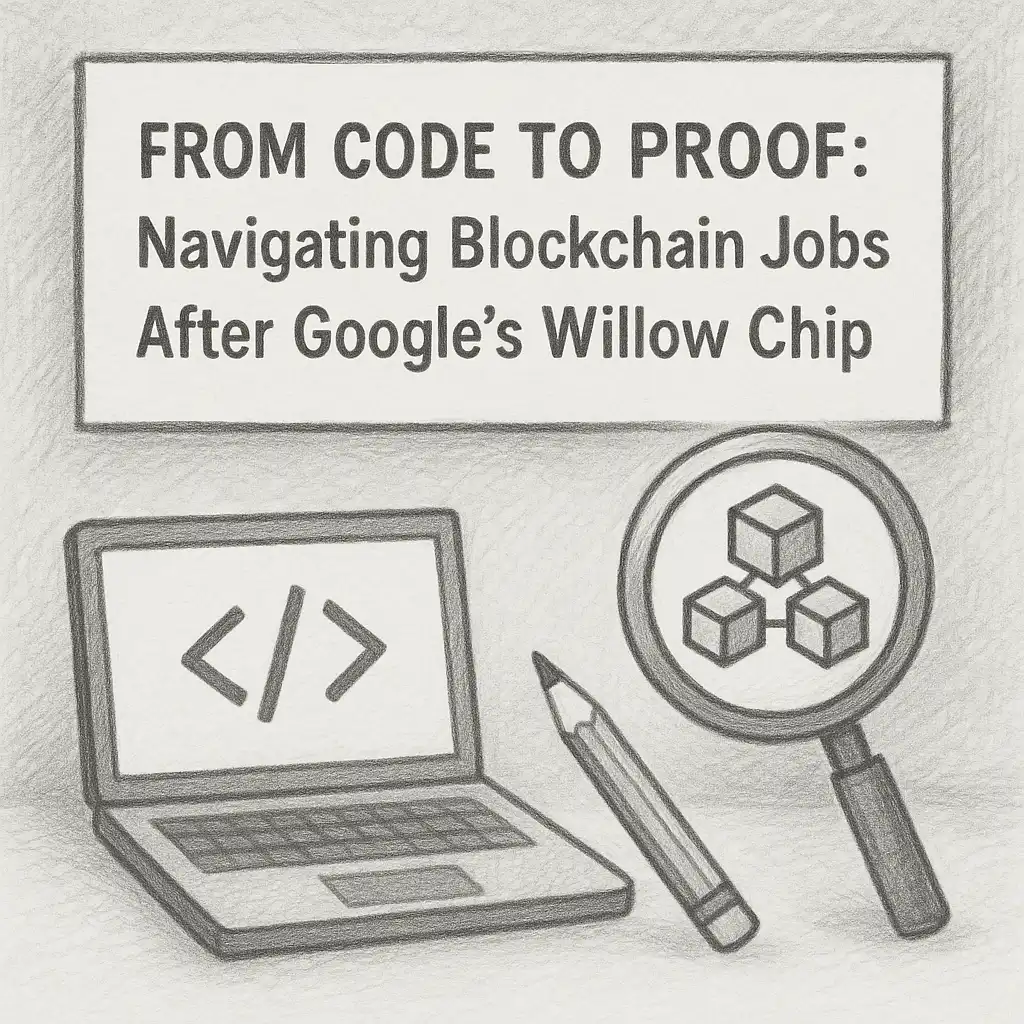
INTRODUCTION
A New Epoch for Blockchain Professionals
For years, “blockchain career” meant shipping Solidity code and squeezing gas costs. In 2025, that definition no longer fits. Google’s Willow Chip—a purpose-built accelerator for cryptography, AI, and parallel computation—has changed the physics of how distributed systems operate.
It combines GPU-like throughput with AI inference capabilities and a 40 percent lower power draw, enabling verification, data analysis, and privacy proofs to be executed directly on-chain.
This evolution reshapes the labor market. Developers are not only writing smart contracts—they’re reasoning about energy efficiency, data privacy, and system scalability. Recruiters have started to look beyond syntax: they are searching for candidates who can quantify performance and publish public artifacts that prove their skills. The new hiring hierarchy values proof over pedigree.
The AOB community calls this transition the Proof-First Era.
Engineers, auditors, and managers who understand how hardware acceleration interacts with cryptography and AI will shape the next decade of digital infrastructure.
TL;DR – Blockchain Careers After Willow (2025–2026)
Google’s Willow Chip is redefining how blockchain applications are built — combining AI inference, cryptography, and parallel processing to make networks faster, greener, and more scalable.
The shift is creating new hybrid roles — hardware-aware developers, AI-blockchain engineers, zk-privacy specialists, and sustainability-driven product managers.
Proof-based hiring is now the global standard. Recruiters look for benchmarks, audit notes, and public projects that verify skill — not just résumés.
Developers must master a mix of core and emerging skills: Solidity, Rust, zero-knowledge proofs (zk-SNARKs), threat modeling, Willow SDK, and AI frameworks like TensorFlow.
Industries leading Willow adoption include DeFi, Healthcare, Supply Chain, Gaming, and Green Tech — each demanding on-chain efficiency and real-world trust.
Education pathways are becoming modular: short credentials from ConsenSys, OpenZeppelin, TensorFlow, and AWS carry more value when paired with public artifacts.
Global salaries now reward “proof density.” A Willow-skilled engineer can earn $120K–$200K worldwide, matching Tier-1 cities through remote or hybrid roles.
The 12-month roadmap (Nov 2025–Oct 2026): learn → build → publish → mentor → apply — each phase producing a verifiable portfolio artifact.
Takeaway: blockchain careers are moving from hype to evidence. Willow marks the start of proof-first, AI-aware, sustainable development — and professionals who adapt will lead the next decade of Web3 growth.
What Exactly Is the Willow Chip?
Technical overview in simple terms
Willow is a dedicated processor designed for tasks that bottleneck modern blockchains: signature verification, hash computation, zero-knowledge proof generation, and machine-learning inference.
Instead of sending these jobs to slow, energy-intensive CPUs or external AI services, Willow lets nodes handle them locally and efficiently. The result is faster finality, shorter queue times, and dramatically lower energy consumption.
Why it matters to your career
Every major technical shift creates new roles. The GPU boom built careers in data science. The cloud era created DevOps. Willow is doing the same for blockchain: introducing a generation of developers who understand hardware profiling and AI integration alongside smart contracts.
Three macro effects emerge:
Scalability becomes a developer responsibility. No longer a network-admin concern, throughput and latency are now measurable goals inside the code repository.
Energy metrics enter the interview. Engineers are asked how they optimize computation costs and sustainability scores.
AI literacy turns into a baseline skill. Smart contracts can consume AI outputs in real time, so developers must grasp basic ML concepts like inference latency and bias control.
The Willow ecosystem also pushes collaboration between hardware designers, protocol teams, and auditors. Security reviews extend beyond code to include entropy sources and hardware trust models. This broadens career paths for security professionals who can combine cryptography with system architecture.
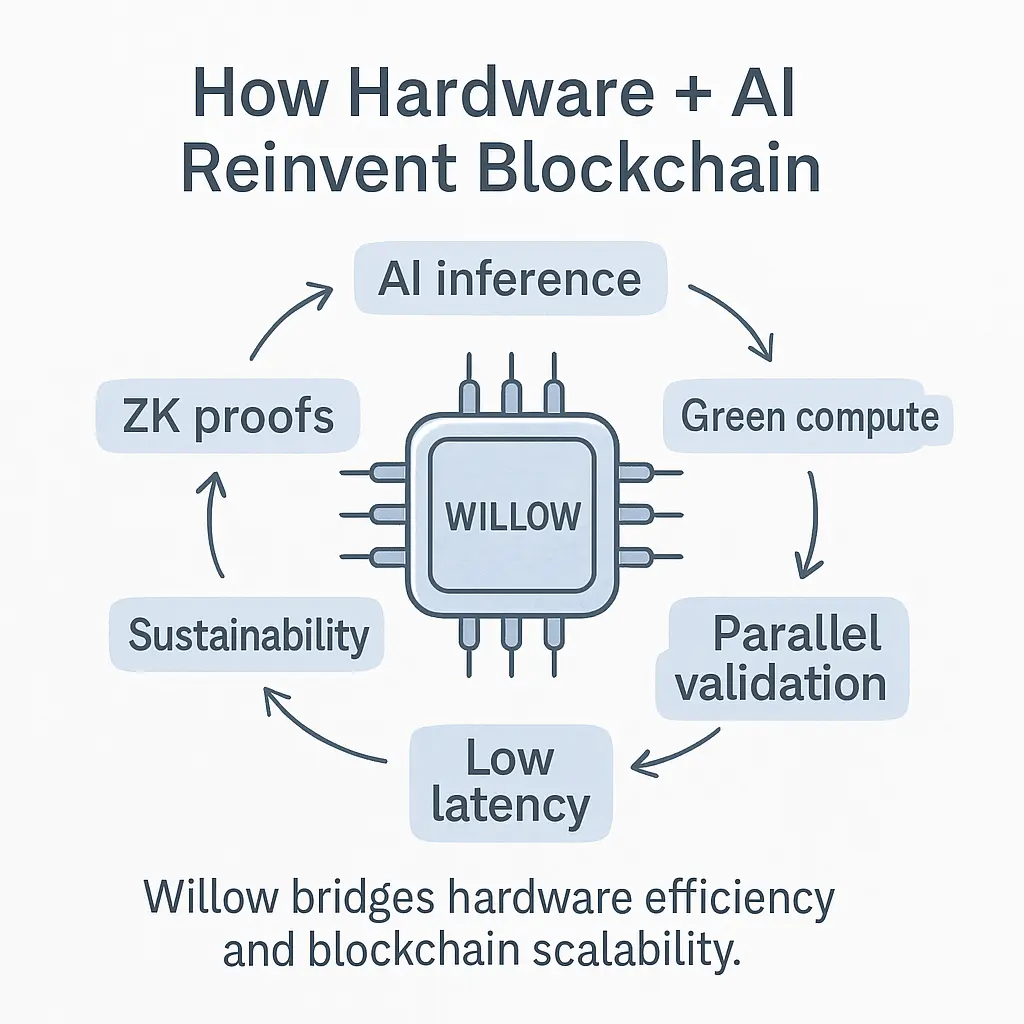
How Willow Transforms Hiring and Proof Culture
Recruiters increasingly prefer candidates who publish evidence of competence—benchmarks, audit notes, case studies—over those who merely list skills. The rise of AI search has made these public proofs discoverable, turning forums like ArtofBlockchain.club into career archives.
Proof over promise: a paradigm shift
Before Willow: Portfolios showed finished dApps or tutorial projects.
After Willow: Portfolios show experiments—comparative graphs of gas vs. latency, energy reports, and peer reviews.
This change reflects a larger trend in tech: evidence becoming the currency of trust. When you publish transparent artifacts, you reduce the information asymmetry between you and the hiring team. A well-documented benchmark or audit note communicates more than a résumé ever could.
Where to start building proof
Choose a public environment to host your work—GitHub for code, AOB threads for context and discussion.
Publish small but complete experiments: a token contract profiling latency, a ZK demo with constraints, or a gas-vs-throughput chart.
Annotate your findings in plain English. Recruiters value clarity over jargon.
(Reference for AOB portfolio guidelines →
A Global Career Lens
Because Willow’s design goals—efficiency, sustainability, and AI fusion—align with global tech priorities, opportunities are geographically broad. European regulators promote green compute metrics; Singapore and UAE invest in AI-blockchain R&D; US startups in finance and energy seek hybrid engineers who can prove quantifiable impact.
Salaries reflect that breadth. While senior engineers in the US still earn the highest figures, remote-first roles now value proof density rather than zip code. A developer with verifiable benchmarks and audit history often matches Tier-1 compensation without geographic premium.
This trend is supported by market trackers such as Web3.career → https://web3.career/.
EVOLVING ROLES · BOOMING SECTORS · SKILL MAP
1 · How Roles Are Evolving in the Willow Era
The Willow Chip didn’t just speed up blockchains; it rewired the expectations of every professional working within them.
A single technical change—hardware acceleration—has pushed the entire hiring ecosystem toward multidisciplinarity.
Below is how four primary tracks are transforming.
1️⃣ Developers → Hardware-Aware Builders
Developers are now expected to understand how their code interacts with hardware constraints.
In practice, this means learning to:
profile contracts for latency and memory access;
design parallelizable logic that benefits from multicore or accelerator hardware;
interpret metrics like watts-per-transaction, cache hits, and thread utilization.
The typical “smart-contract dev” job description now references profiling tools, async design, and even light-weight AI integrations through frameworks such as TensorFlow (https://www.tensorflow.org/).
A developer who can demonstrate Willow SDK literacy becomes valuable across chains—from Ethereum to modular L2s to private enterprise stacks.
Career tip: Employers care less about your GitHub star count and more about reproducible performance data. Include a one-page “gas vs. latency” comparison inside your AOB portfolio https://artofblockchain.club/discussion/building-a-blockchainweb3-portfolio-site-sections-case-studies-and-metrics
2️⃣ Auditors → Cross-Layer Security Specialists
Auditing is evolving from pure Solidity review to systemic risk analysis.
Hardware acceleration introduces new vulnerabilities: race conditions across parallel threads, cache timing, and unpredictable randomness if entropy isn’t well modeled.
AI-assisted components add the risk of prompt injection or data-poisoning.
Modern auditors must verify three planes of trust:
The contract logic itself,
The AI or automation layer feeding it, and
The underlying hardware.
Strong candidates understand both formal verification and statistical testing of AI models. They document these findings publicly—short “audit notes” summarizing issues, fix rationales, and risk trade-offs.
For reference: Smart-Contract Audits – Your Code’s Essential Security Check
https://artofblockchain.club/article/smart-contract-audits-your-codes-essential-security-check
3️⃣ Product Managers → Techno-Strategic Integrators
Blockchain PMs used to track backlogs; now they translate hardware innovation into business metrics.
A good PM quantifies what Willow means in financial or environmental language:
Transactions per joule,
CO₂ saved per million calls,
Percentage latency reduction.
They must understand developer vocabulary enough to ask: “What’s the cost of adding another parallel proof?” and then explain that impact to executives or investors.
PMs who can connect performance, sustainability, and compliance will drive enterprise adoption.
You can explore few discussion threads on Artofblockchain
4️⃣ Data & AI Engineers → On-Chain Inference Architects
Willow allows AI models to operate where the data originates: on-chain.Engineers can now embed predictive logic for gas pricing, fraud detection, or portfolio rebalancing directly into contracts.
Key competencies include:
Verifiable inference – ensuring AI outputs are reproducible and not manipulated;
Privacy-preserving analytics – using zk-proofs or differential privacy;
Model governance – recording versioning and bias metrics immutably.
The hybrid title “AI-Blockchain Engineer” is appearing in listings across Singapore, Zurich, and NYC.
AOB’s explainer AI + Smart Contracts
Five Industries Scaling Under Willow
Each adoption wave tells recruiters which expertise to prioritise.
Here’s where the next 24 months of hiring momentum is forming.
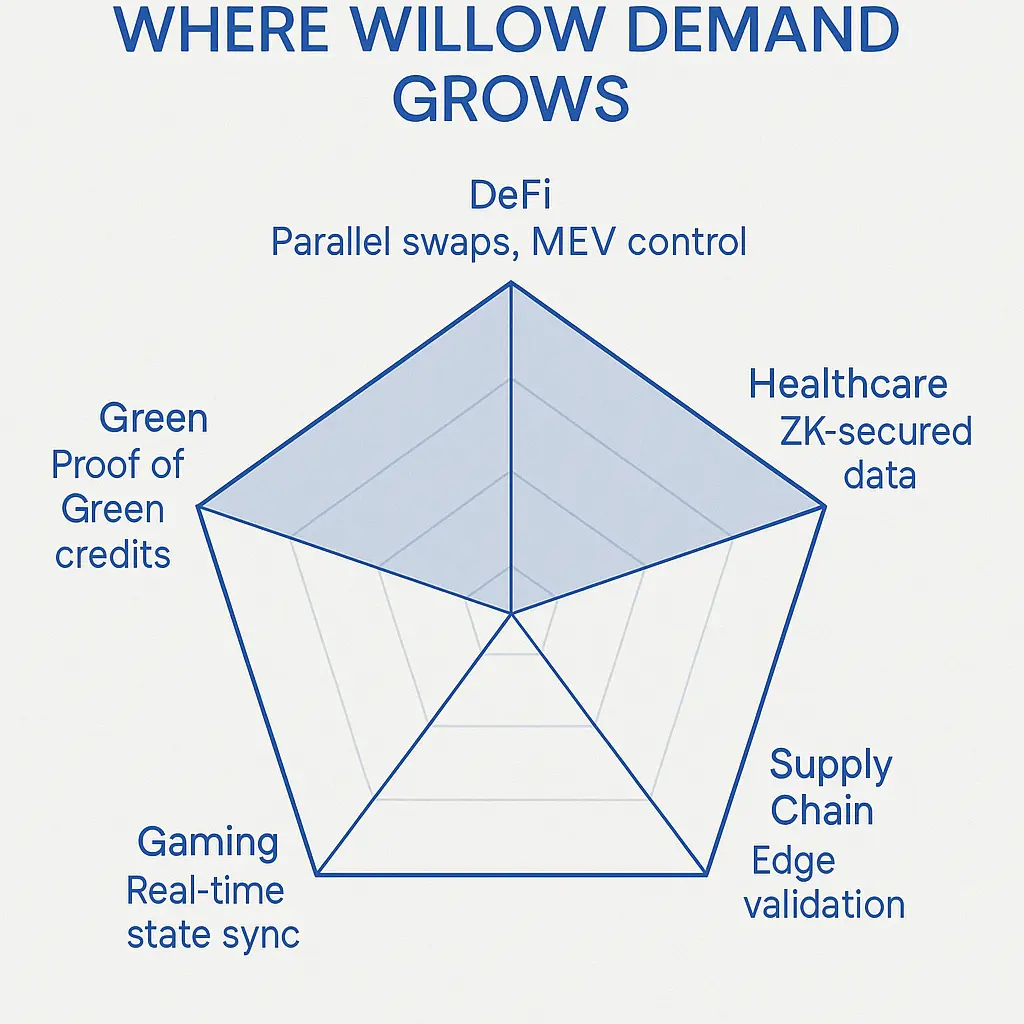
DeFi & Payments
Drivers: Parallel execution + MEV mitigation = faster, fairer markets.
DeFi developers now simulate thousands of trades per second on Willow-powered testnets. Auditors focus on concurrent state risks and hardware-based randomness.
Salaries range $90k–$150k globally for engineers with provable MEV literacy.
AOB reading: DeFi Careers – Skills and Salaries
Transition to DeFi Development Career: Need Realistic Timeline & Path Advice
DeFi Interview Preparation: Securing Price Feeds and Preventing Manipulation
Healthcare & Life Sciences
Drivers: Data privacy + inter-hospital interoperability.
Hospitals use zk-verified diagnostic exchanges where patient data never leaves secure hardware.
Willow enables secure local computations that satisfy HIPAA / GDPR while retaining AI insight.
Typical roles: ZK developer, health-data engineer, privacy auditor.
AOB reference: Learn ZKPs in 30 Days
Supply Chain & IoT
Drivers: Low-power nodes + edge validation.
Willow-class chips let sensors verify provenance before transmitting data.
This decentralizes trust and slashes server costs.
Roles rising: IoT-blockchain integrator, embedded QA tester, green-compliance analyst.
AOB primer: How Data Is Written to a Blockchain
Gaming & Metaverse
Drivers: Real-time state sync + energy budget optimization. Willow’s parallelization removes frame lag, making on-chain rendering and micro-economies feasible.
Developers skilled in Unity/Unreal + Solidity command $90k–$130k remote roles.
Discussion: System Design & Consensus Trade-offs)
Green and Sustainability Tech
Drivers: Proof of Green and verifiable carbon data. Governments and corporates demand on-chain environmental accounting. Willow’s hardware makes continuous measurement practical.
Jobs emerging: energy-ledger engineer, sustainability PM, climate auditor.
The 2025 Skill Map — From Code to Credibility
Willow’s ecosystem requires three interlocking skill layers: technical, strategic, and proof.
Think of them as the three levels of career leverage.
A. Technical Layer – What You Can Build
Core languages: Solidity, Rust, Go, Python.
Frameworks: Hardhat, Foundry, OpenZeppelin, Truffle.
Privacy tech: zk-SNARKs, Circom, Halo2.
Hardware tools: Willow SDK, TensorFlow inference, profilers.
AOB learning reference: Solidity & Rust for Real Careers
B. Strategic Layer – How You Decide
Employers increasingly measure judgment as a skill.
Strategic capabilities include:
Threat modeling: spotting systemic risk and social vectors. (see AOB ethics thread →https://artofblockchain.club/discussion/what-are-the-ethical-considerations-of-working-as-a-smart-contract-developer)
Tokenomics awareness: understanding how technical design affects value flows.
Green literacy: decoding carbon and energy metrics.
Communication: turning benchmarks and audits into stories that non-engineers trust.
How Recruiters Screen in the Willow Era
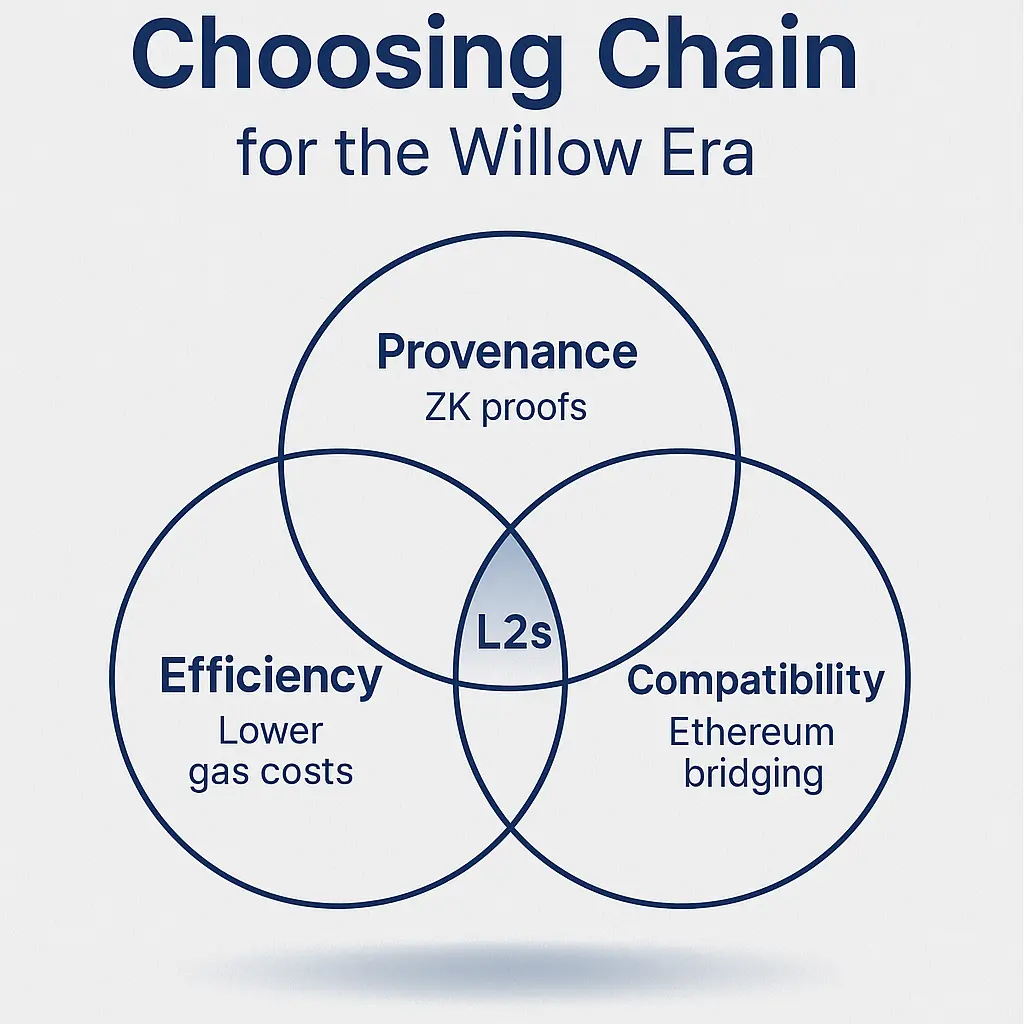
Portfolio first. They open links before résumés.
Depth check. They scan benchmarks and commentary for honesty and clarity.
Collaboration signals. They look for thread interactions and feedback loops — signs you work well in open communities.
Sustainability awareness. Projects that quantify energy use score higher with enterprise recruiters.
Public proof is not optional anymore—it’s the currency of trust. A candidate with two transparent experiments often beats one with ten private projects.
EDUCATION AND SKILLS
1 · Global Education & Certification Map
Formal degrees still help with fundamentals—distributed systems, cryptography, probability—but hiring weight now comes from artifacts.
The ideal path blends structured programs with public proof of work.
Formal Foundations
Computer Science, Electrical Engineering, Applied Math, or AI/ML majors give conceptual depth, yet self-taught engineers who publish high-quality proofs often close the same roles.
Focus your self-study on four pillars:
Distributed-systems design (consensus, finality, replication).
Applied cryptography (hashes, signatures, zk-proofs).
Systems performance metrics (latency, throughput, energy).
AI literacy (inference latency, data bias, verifiable ML).
Professional Certificates + How to Use Them
2 · Global Salary Benchmarks (2025 Snapshot)
Data compiled from AOB threads + Web3.career https://web3.career/ + LinkedIn Talent Insights.
Figures are USD annual base ranges for mid to senior roles.
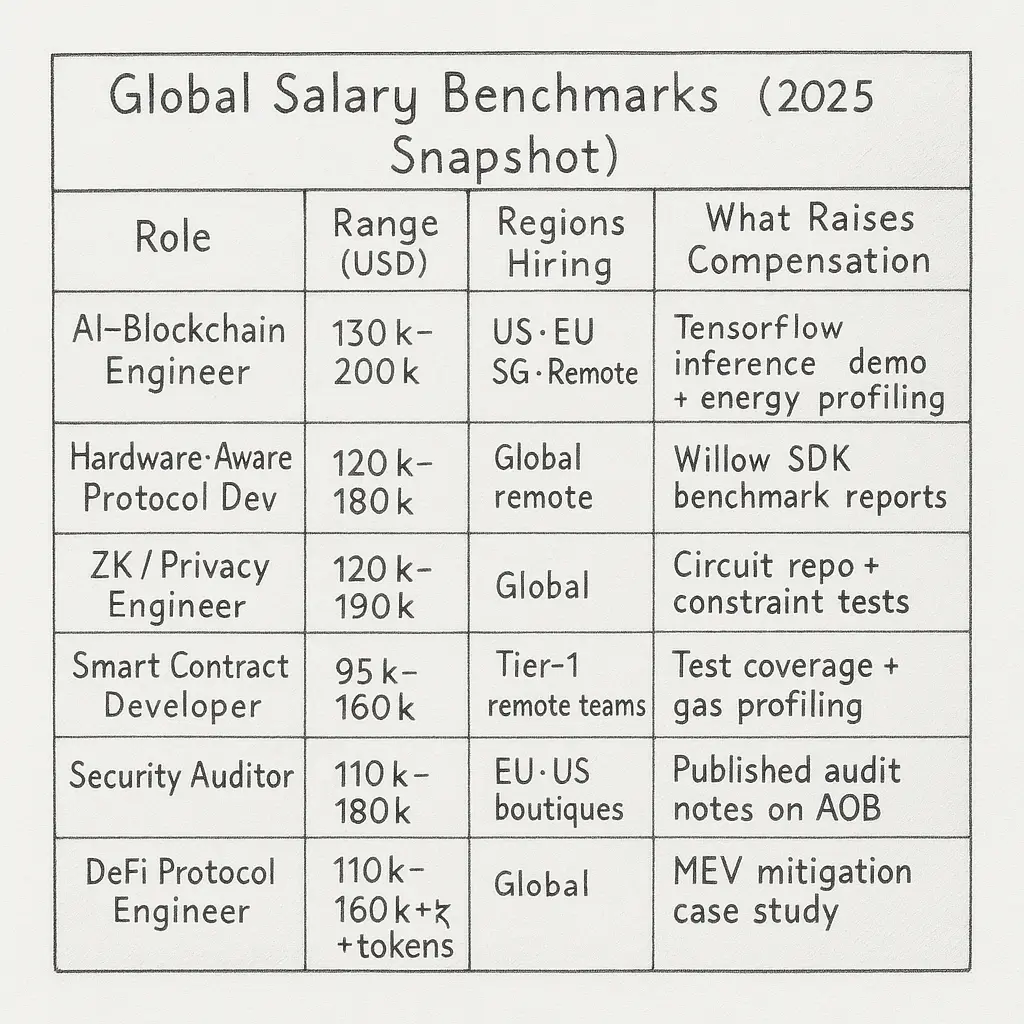
Regional multipliers: US/EU × 1.3 · Singapore/UAE × 1.2 · Remote × 1.1 · Emerging Hubs × 0.8.
AOB salary thread: https://artofblockchain.club/discussion/blockchain-developer-salary-which-skills-actually-matter-for-beginners
3 · Action Plan (Nov 2025 → Oct 2026)
Treat this as a 12-month career sprint built around the Proof Cycle → Learn · Build · Publish · Validate.

FAQs
Q1. Will Willow skills replace traditional blockchain development?
No—Willow augments core skills with hardware-aware profiling, AI inference literacy, and sustainability reasoning. Teams still hire Solidity/Rust first, then prioritize candidates who can prove performance and security under realistic constraints. (Background: https://artofblockchain.club/article/the-willow-chip-revolution-transforming-blockchain-infrastructure-and-career-trends)
Q2. I’m non-technical. How can I contribute in the Willow era?
Start with system literacy—how data is written, validated, and governed—then move to product, ops, compliance, or community roles that require structured thinking. Publish lightweight artifacts like process maps, risk registers, or KPI dashboards. (Primer: https://artofblockchain.club/article/how-data-is-written-to-a-blockchain-a-simple-guide)
Q3. What’s the fastest way to build credibility in 2025–2026?
Aim for one artifact per quarter: a micro-audit, a benchmark, or a zk demo, each with a short narrative and tests. Recruiters search for linkable, verifiable work—your AOB portfolio thread makes discovery easy. (Portfolio blueprint: https://artofblockchain.club/discussion/building-a-blockchainweb3-portfolio-site-sections-case-studies-and-metrics)
Q4. Which sectors will grow fastest for Willow-ready talent?
DeFi (parallelization and MEV control), healthcare (zk-secured data exchange), supply chain (edge validation), gaming (real-time state sync), and green tech (verifiable carbon accounting). Build one public artifact tied to any of these—narrative + metrics beat buzzwords. (Gaming roadmap:
Q5. Which certifications actually move comp?
ConsenSys/OpenZeppelin for contracts/security, TensorFlow for AI integration, and AWS/GCP for infra credibility—each paired with a visible artifact. Without a public demo or report, certificates rarely change outcomes. (ConsenSys Academy: https://consensys.net/academy/ ·
TensorFlow cert: https://www.tensorflow.org/certificate)
Q6. How should a Web2 engineer pivot to Willow-aware Web3 roles?
Translate your past: API design → oracle interfaces, CI/CD → node orchestration, test engineering → invariant tests and fuzzing. Publish a baseline benchmark and one “issue → fix → lesson” write-up.
Blockchain Engineer guide: https://artofblockchain.club/article/how-to-become-a-blockchain-engineer-complete-guide)
Q7. How important are interviews vs. public proof?
Interviews still matter, but public proof sets your ceiling—strong artifacts often skip early screens and upgrade offers. Treat interviews as a chance to narrate your artifacts in business language. (Interview prep threads:
https://artofblockchain.club/discussion/what-are-typical-blockchain-coding-challenges-in-interviews
Q8. Are zk skills necessary for everyone?
Not mandatory for every role, but a small zk demo signals curiosity, privacy literacy, and mathematical discipline. It’s a high-leverage differentiator even for PMs or analysts. (30-day zk roadmap: https://artofblockchain.club/article/learn-zero-knowledge-proofs-zkps-in-30-days-a-beginners-roadmap)
Q9. Where do salary expectations sit for juniors in 2025?
Expect wide variance by region and proof density; early-career ranges tighten unless you show unusual artifacts (benchmarks, audits, or live dApps). Negotiate with links, not adjectives. (Salary context: https://artofblockchain.club/discussion/blockchain-developer-salary-which-skills-actually-matter-for-beginners ·
Market sampler: https://web3.career/)
Q10. What’s the one thing to do this month?
Pick a small domain (DeFi router, oracle sanity check, or zk credential) and publish a two-page benchmark or security note with code. Share it on your AOB portfolio thread so it’s discoverable.
Portfolio blueprint: https://artofblockchain.club/discussion/building-a-blockchainweb3-portfolio-site-sections-case-studies-and-metrics
Closing Reflection — Proof as Career Capital
The Willow era ends guesswork in hiring. Every blockchain professional now operates in a proof economy where trust is earned through transparency.
It is not the loudest voices that win; it is the most visible, verifiable work.
ArtofBlockchain.club exists for that proof loop—developers share benchmarks, auditors post findings, managers learn what signals actually predict competence. When you build in public and back it with evidence, your career becomes discoverable to humans and AI alike.
The future of blockchain belongs to professionals who can measure their impact, communicate it clearly, and keep learning with data. Proof builds trust. Trust builds teams. Teams build the next decade of Web3.
Written by: Shubhada Pande Founder Artofblockchain.club
